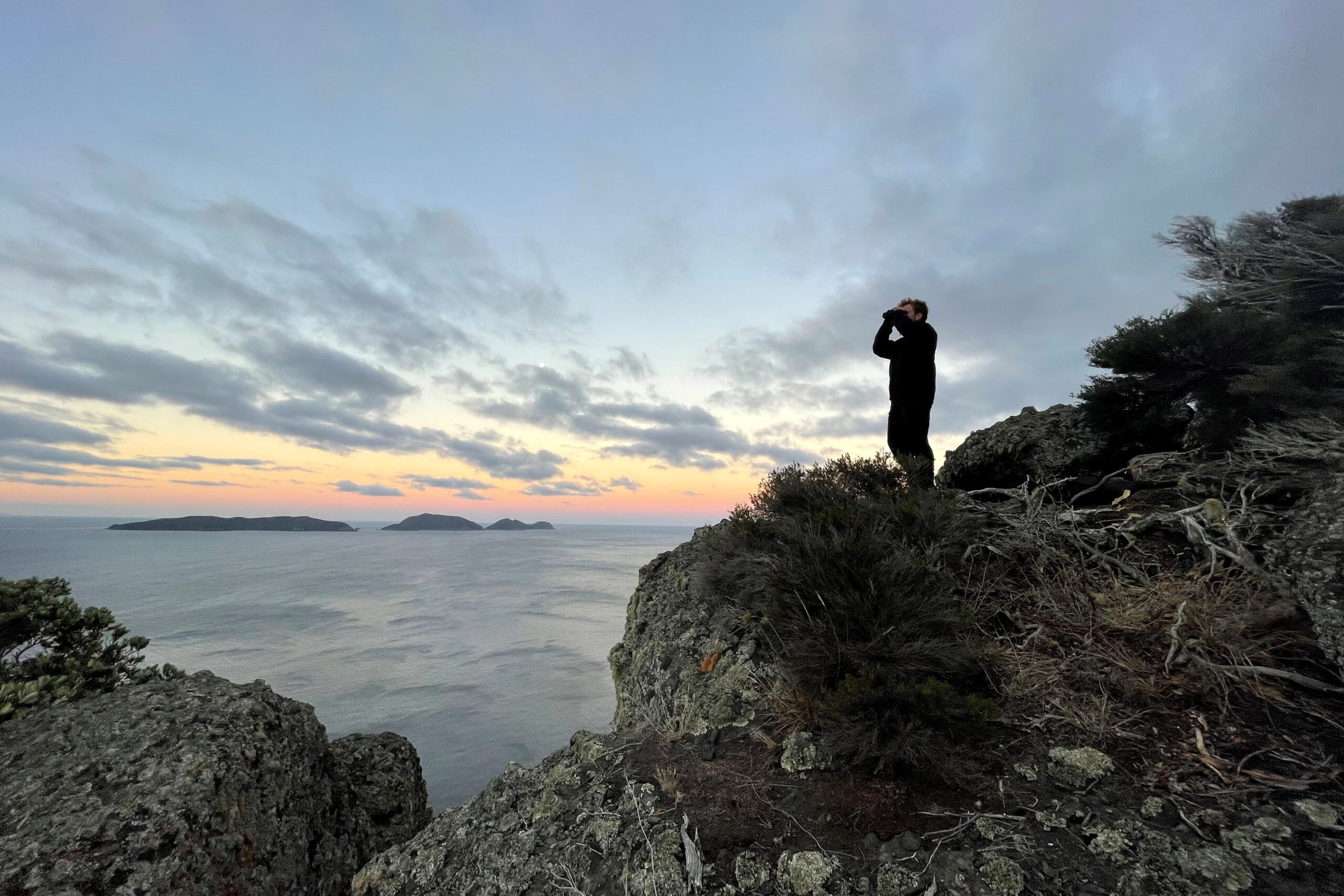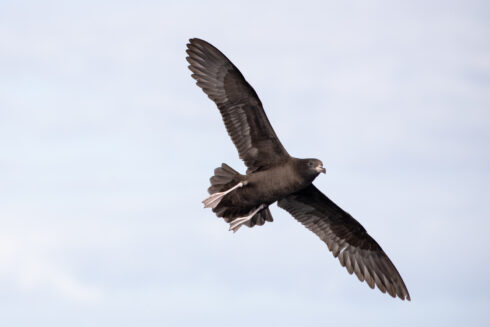
Dan Burgin, eBird Reviewer
Did you know there are over 2,000 volunteer eBird reviewers around the world? Volunteer reviewers play an important role ensuring the eBird database remains reliable and accurate for science and conservation (learn more about the eBird review process). eBird is incredibly grateful to our volunteer reviewers for their dedication to eBird’s data quality.
The eBird Reviewer Spotlight helps you get to know eBird’s volunteer reviewers a little better. These articles are written in the reviewer’s own words and reflect their experiences as reviewers, eBirders, and members of the birding community. In this spotlight, Dan Burgin, eBird regional reviewer for New Zealand, describes how he became an eBird reviewer, his contributions to the New Zealand Bird Atlas, and the value of eBird to bird conservation.
eBird Reviewer Spotlight: Dan Burgin
I work as an ecologist in Aotearoa, New Zealand, for Wildlife Management International Limited (WMIL), undertaking bird research and conservation work around the country with a particular focus on seabirds and shorebirds. I’ve always had a love for wildlife and wild places, but I got into birding quite late to be honest. Bird photography came first, with my spark bird being the Charming Hummingbirds I saw while traveling in Costa Rica. It was only when I traveled to Aotearoa that I began to learn from colleagues the value of taking note of everything I was seeing and hearing into checklists in eBird. From there, using eBird has grown into a daily habit. In hindsight, I wish I’d gotten into birding far earlier, as it has given me so much joy and purpose and taken me on some amazing adventures.
How did you become an eBird reviewer?
I became a reviewer in 2019 as part of my role within the New Zealand Bird Atlas Coordination team.
What work do you do as a reviewer for New Zealand?
I review eBird records for the Marlborough, Tasman, and Nelson regions, whilst also assisting with other regions when needed. As part of being a reviewer, I review flagged rarities and high counts, as well as assist users with identification issues or checklist level issues. My role as reviewer has tied in with being part of the New Zealand Bird Atlas Coordination team, as I have regularly contacted observers over the years about the project to see if they’d be keen to join the Atlas community. This meant often helping them upload their observations to the NZ Atlas portal, as well as make a few recommendations to increase the scientific value of their observations. This is accomplished by uploading complete checklists with accurate abundances for all species and increasing the resolution of their checklists over time and space.
I understand you serve as part of the New Zealand Bird Atlas Coordination team. What is a Bird Atlas? What makes the New Zealand Bird Atlas important?
Great question. A ‘Bird Atlas’ essentially attempts to provide information on the distribution, abundance, long-term change, and seasonal patterns of bird occurrence within a certain region or country over a set period of time. There are numerous ways of doing them, each with different methods and aims, and many Atlas projects are often focused on breeding bird records. The New Zealand Bird Atlas is slightly different in that it is a year-round survey with the aim of gathering data on the distribution and abundance of all of the birds in Aotearoa over the five-year period, in order to provide up to date information for bird research and conservation. Each participant therefore had to try to detect/observe all of the possible species within each grid square, across all four seasons.
This is the third New Zealand Bird Atlas run by Birds New Zealand (Ornithological Society of New Zealand). It began June 1, 2019 and will end May 31, 2024. The first NZ Atlas project ran from 1969-1979, and the second project ran from 1999-2004. What this Atlas will therefore provide is an invaluable long-term record to help document how birds of Aotearoa have changed in distribution over a number of decades. This is important for a myriad of reasons, notably to help mitigate the negative impacts of shifting baseline syndrome, and better inform conservation for birds in Aotearoa. New Zealand’s bird species face numerous threats on a daily basis with many sadly heading towards extinction. We need regular up to date information on where bird species are, and in what numbers, to better inform effective conservation management and research. So, this Atlas project has been very important in engaging more of the birding, and bird-loving, community to work together towards a common goal.

A flesh-footed shearwater, or toauni, is a species that Dan has monitored at several breeding sites in New Zealand. © Dan Burgin / https://macaulaylibrary.org/asset/324661311
How did you become part of the Atlas Coordination team? What work does it require from you?
WMIL was contracted to coordinate the NZ Bird Atlas on behalf of Birds New Zealand, and so through my role as an ecologist at WMIL, I was fortunate enough to become part of the team. It’s been a real privilege, and coordinating the Atlas involves a mix of responsibilities. A key role is supporting the community involved, amongst many others such as checking on the data being submitted and ensuring it is running smoothly. We’ve undertaken lots of advocacy for the project to encourage people to get involved, through magazine articles, radio interviews, and social media outlets. I even got the opportunity to write an article for the global eBird News page to encourage any traveling birders to contribute too! We’ve also worked to build capacity within the volunteer eBird review team as the Atlas has caused a surge in data uploads. We’ve also run six Atlas expeditions to target under surveyed areas around the country, and these have been kindly funded by Toi Toi Wines New Zealand, to help offset the costs of fuel and accommodation.
The data has already been requested by various stakeholders over the years, and as part of the role we have engaged with those stakeholders to encourage them to upload any bird observation datasets they may be managing. This has led to multiple regional councils uploading their data, as well as us working with the Department of Conservation to upload their national Tier 1 bird count datasets to the Atlas portal. This has helped not only increase the quality, quantity and coverage of Atlas data, but also helped show stakeholders the value of contributing towards the database as well as utilizing it.
What challenges were associated with the New Zealand Bird Atlas?
We’ve had a few key challenges during the lifetime of the project. Ensuring the community remained engaged and was enjoying the project, and ensuring data coverage is spread across the country. We tried to gain funding for the remaining two years of coordination but were unsuccessful, so the latter two years of coordination have been voluntary. As you can imagine, we wanted to ensure that the data collected by participants was as scientifically valuable as possible. So, we came up with the ‘Atlas essentials’ for the community to follow. As a consequence, the quality of the majority of data flowing into the NZ Bird Atlas eBird portal is high, namely through being complete checklists, with accurate abundances for all species, and of high resolution over time and distance.
The eBird team has been fantastic in helping us face some of those challenges, providing support and a custom-made Atlas portal for us all to use with fantastic resources. This allowed this Atlas scheme to be the first in its history to be a digital-first project. With eBird offering real-time data entry and outputs, the Atlas community was able to enter observations directly through the eBird app, as well as follow along with results throughout the project, either through the main page or the Atlas Effort Map. This was a far cry from the paper-based days of previous Atlas projects!
The project also ran through the COVID-19 pandemic, as well as a surge in the cost of living. Despite the lockdowns and rising costs, the community came together, determined and as passionate as ever to collect this expansive dataset. This was a project that was dependent on a community united by a shared passion, and we’ve been blown away by how the community has come together to meet the aims of the project. We cannot thank all of those who have participated enough for their involvement these past five years and for taking the time to come together and gather such an impressive dataset within such a short period of time. Projects like these are nothing without passionate people dedicating their time and effort, and I believe that true for the wider eBird project globally. It’s been a real honor to be a small part of such a big achievement.
What can eBirders do to help with the review process?
A few small actions can make a big difference. Uploading to an appropriate portal, uploading complete checklists (i.e., everything you personally were able to identify by sight and/or sound, without intentionally leaving anything off), and adding in as much information as possible when you trigger a filter. If it’s for a rarity, take the time to describe how you identified the species and how you differentiated it from other similar looking species. For a high count, simply stating how you got to that count of that species can be really useful to a reviewer. Also lean into the amazing variety of spuhs and slashes available to help with the inevitable uncertainty when birding; there’s no shame in using them!
Finally, responding positively and promptly to a reviewer is always welcomed, they’re just trying to help and are volunteering their time often as part of their busy lives.
Anything else you’d like to share?
Thanks to the eBird team for all that they do for the global community. It is an incredible resource and I can imagine it is no easy task supporting a global birding community! eBird has helped allow the New Zealand Bird Atlas project to support and inspire a community to come together for a common goal and enjoy birds even more. We have every faith it will also better inform conservation and research here in Aotearoa. We hope that, once the Atlas finishes in 2024, many of the community will continue to submit their valuable birding observations on a regular basis to the New Zealand eBird portal. With climate change and biodiversity loss often a huge worry for birders, it can leave you feeling helpless as to how best to make a tangible change. You can make a difference by regularly submitting your bird observations to eBird and can be empowering to know you are part of a global community making a positive change by doing something we all love; watching and taking note of the birds around us.

From top right clockwise: Dan’s photos of the mountains, braided rivers, the sea, and coastal margins, as there is valuable bird data to be gathered at these habitats across Aotearoa, New Zealand.
